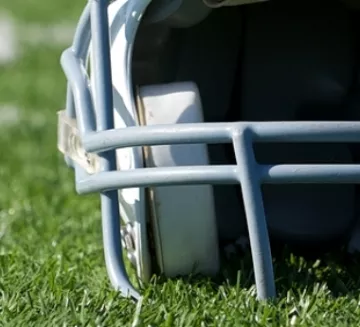Case Study
Head / Turf Impact
While performing some unsupervised pre-season “drills” without the use of a helmet, the athlete attempted to jump off a fellow athlete and grab the horizontal crossbar on one of the field goal posts. In doing so, he fell 8-10 feet onto the field surface. Testimonial evidence indicates that he was knocked unconscious and may have begun seizing after the incident.
The athlete was initially diagnosed and treated for a concussion and returned to practice after following the mandatory protocol. However, upon his return, reoccurring symptoms presented themselves making further medical treatment and evaluation necessary. A diffuse axonal injury (DAI) was subsequently diagnosed, which is a primary result of the brain's rotation relative to the skull during rapid head accelerations such as striking your head on a turf playing surface.
The question was then posed as to whether or not the sustained injuries could have been prevented or reduced had the athlete been wearing a football helmet.
With the frequency and seriousness of sports-related injuries, do we have a bigger responsibility to take more preventative measures?
Whether you’re in the stadium, on the practice field, or running up and down the court, there’s always the risk of injury. By far the most prevalent injuries in all sports activities are relatively minor musculoskeletal injuries such as cuts, abrasions, sprains, and strains. Also prevalent, but still only moderately severe would be the ligament and tendon tears, joint dislocations, and even broken bones. Although much less common, head injuries have become more and more of a concern as our knowledge and ability to analyze such injuries has advanced. When an injury does occur, questions often arise about how it was sustained and whether it could have been prevented. The science of biomechanics can provide the answers to these and other related questions.
Recently, an incident on a turf playing surface that resulted in traumatic brain injury (TBI) to an athlete without any head protection brought these very topics to light. Could the damage have been avoided or mitigated if the athlete had been wearing a helmet? S-E-A was asked by the state to complete a biomechanical investigation and analysis of the incident to answer this, among other key questions in the case.
Assigned Task:
S-E-A was asked by the state to complete the necessary investigation and biomechanical analysis to understand the exposure of this athlete in this incident and to determine the effects a football helmet would have had with respect to his brain’s exposure.
To perform the analysis, S-E-A took the following steps:
- Investigated the field turf standards in relation to impact resistance. This included obtaining G-Max test results of the subject field both before and after this incident.
- Performed a biomechanical evaluation of the incident based on testimonial and medical evidence.
- Completed computer simulations replicating the athlete’s anthropometry, the incident scenario, and the field turf impact characteristics.
- Biomechanically evaluated the various head injury metric results from the computer simulations to verify injury mechanisms and to determine the likely effects of football helmet use with respect to both injury mechanisms and those metrics in this particular incident scenario.
The investigation and analysis resulted in the following findings:
- There was no evidence to suggest that the field turf in question did not adhere to the standards or regulations at the time of the accident.
- The athlete sustained a head injury due to the impact and angle in which he hit the turf as a result of losing his grip on the horizontal cross bar of the field goal post.
- The dynamics in which the athlete’s injuries were sustained suggests that a concussion with diffuse axonal injury was the inevitable outcome.
- The use of a football helmet would not likely have prevented the specific brain injuries in this incident.
S-E-A’s ability to accurately evaluate and recreate accidents relies to some degree on expertise using and combining a broad range of advanced technologies. More importantly, S-E-A engineers operate in specialized multi-disciplinary teams with the deep understanding garnered from extensive field experience within their specialties.
S-E-A’s multi-disciplinary teams are a large part of the reason why we have been able to help so many clients. Our scientific methodologies cross all disciplines and our wealth of experience solving a wide range of problems is invaluable in assuring broad perspective and thinking unfettered by familiarity and repetition.


